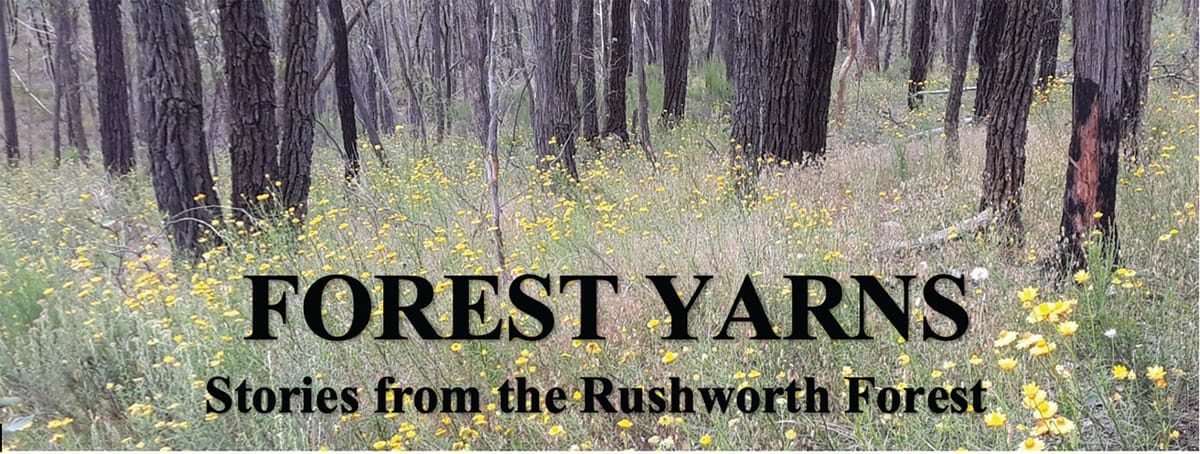Telegraph poles

One of the early products coming out of the Rushworth forest was telegraph poles. Electric telegraph was introduced into the new colony of Victoria in 1854. For the first time, it was possible to send a message almost instantaneously rather than wait for what was then a relatively unreliable postal service. At the time, the telegraph was a startling innovation, probably about the equivalent to the introduction of email in recent decades.
The Rushworth Post Office was established in September 1857. At the same time telegraph lines were set up from Melbourne to Bendigo, but Rushworth did not get the telegraph until December 1874. By then, telegraph lines were being established all over Victoria. The branch line to Rushworth came off the main northeast line at Mangalore, reaching the town five years before it got to Shepparton.
Poles were required to carry the telegraph lines. With the later advent of the telephone (first introduced in Rushworth with nine subscribers in 1908) and electricity (to Rushworth in 1914), there was an ongoing market for poles.
Tenders
Because the telegraph and telephone poles were all required by government departments, tenders were called for by government department such as the State Forests Department, the Victorian Railways and the Postmaster General’s Department (PMG) in the Victorian and Commonwealth government gazettes. This also applied to power poles when the State Electricity Commission was set up by a 1918 act of parliament. The specifications were usually made available at places like the Rushworth railway station, so local contractors had a chance to submit tenders.
For instance, the McDonald Bros of Rushworth successfully tendered for several contracts with the PMG in 1911, for nearly 1250 telegraph poles.1 The poles, which in these contracts ranged between 25 and 40 feet long (7.6 – 12.2 metres), had to meet rigid specifications. There were two categories – “stout” and “ordinary”. The timber was to be red ironbark, white ironbark or grey box. All up, the contracts yielded over 1800 pounds (about $120,000 in 2024 $A) for the contractors.
The poles mostly ended up in northern and north-central Victoria, although one contract of 290 poles went to the Warrnambool district of south-western Victoria.1 Earlier, it had been stated that “the poles used in electric lighting in Bendigo came from the Heathcote and Rushworth reserves…as well as 997 telegraph poles.”2 Poles for the first electric lighting in Kyabram also came from the Rushworth forest.3
Number of poles
The poles that were sourced by the contractors had to be long and straight, so they had to go through the forest and be very selective about which trees were taken.
How many poles came out of the forest? The evidence is sketchy, apart from the period from 1917-42. During that period, the forest officers in Rushworth maintained records of forest output which are held in the Public Records Office of Victoria (PROV). In that 25-year period, about 38,000 poles were sourced from the forest.4
Prior to 1917, there were occasional mentions of the output, including a statement at a 1910 forest inquiry which claimed that 5000 poles had been despatched from Rushworth in one year.5 The output for the 1953 year was 9000 poles.6
Transport
Timber jinkers were used to bring the poles out of the forest. These were long-framed trailers, which could accommodate the poles up to more than twelve metres, set on wheels. They were originally drawn by a team of horses, and later by traction engines and then trucks. Some of the early jinkers had wooden wheels, such as the one that can be seen on display near the wharf in Echuca.
PMG pole depot
In later years, the PMG had a depot off the Rushworth-Whroo Road for poles that had been sourced out of the forest. This was known locally as the creosote works. A product called creosote was derived from the tar from various raw materials such as wood, coal or charcoal and used as a preservative for the poles. The creosote helped increase the longevity of the poles by being an active ingredient in the control of pests such as termites and fungus.
There is a downside to the use of creosote in pole preservation. It has been classified as a Category B carcinogen in Europe and moves are afoot to further control its use. As a result, many European countries have already banned the use of creosote7. If you have access to old poles and are thinking of using them as firewood, it is probably best to have a rethink, particularly if the creosote used is coal-tar based.
References: 1. Government Gazettes 1911; 2. Bendigo Independent 21/1/1904; 3. Kyabram Free Press 7/7/1912; 4. PROV, State Forests Output Books (Rushworth 1916-29 and 1929-42); 5. Bendigo Advertiser 29/9/1910; 6. Kyabram Free Press 17/6/1954; 7. polesaver.com/blog




